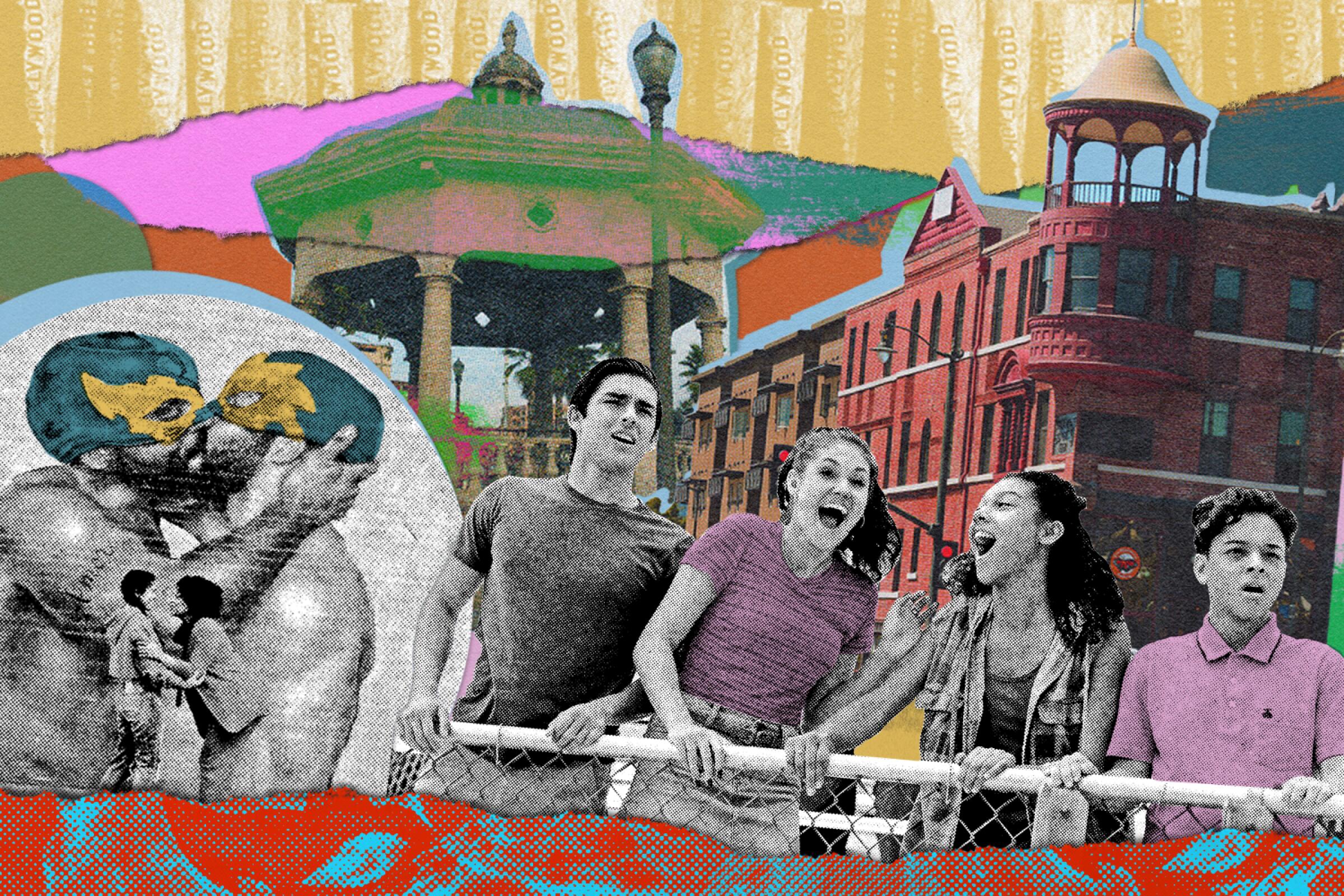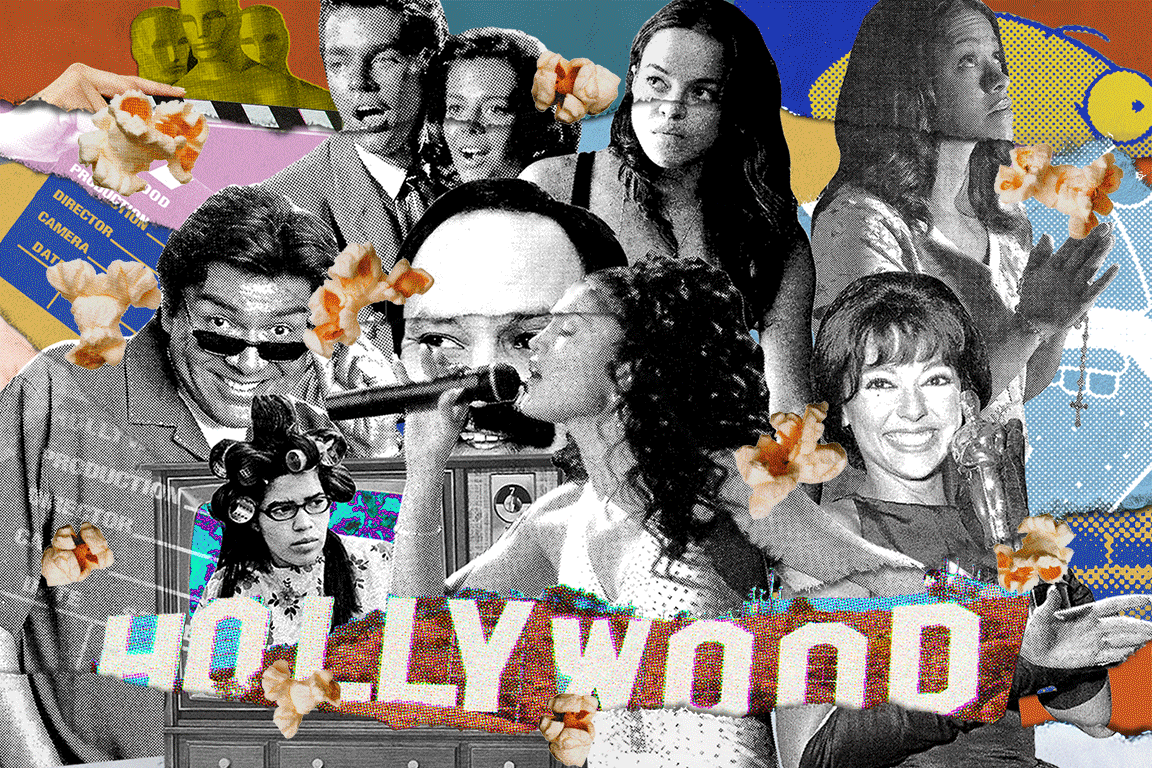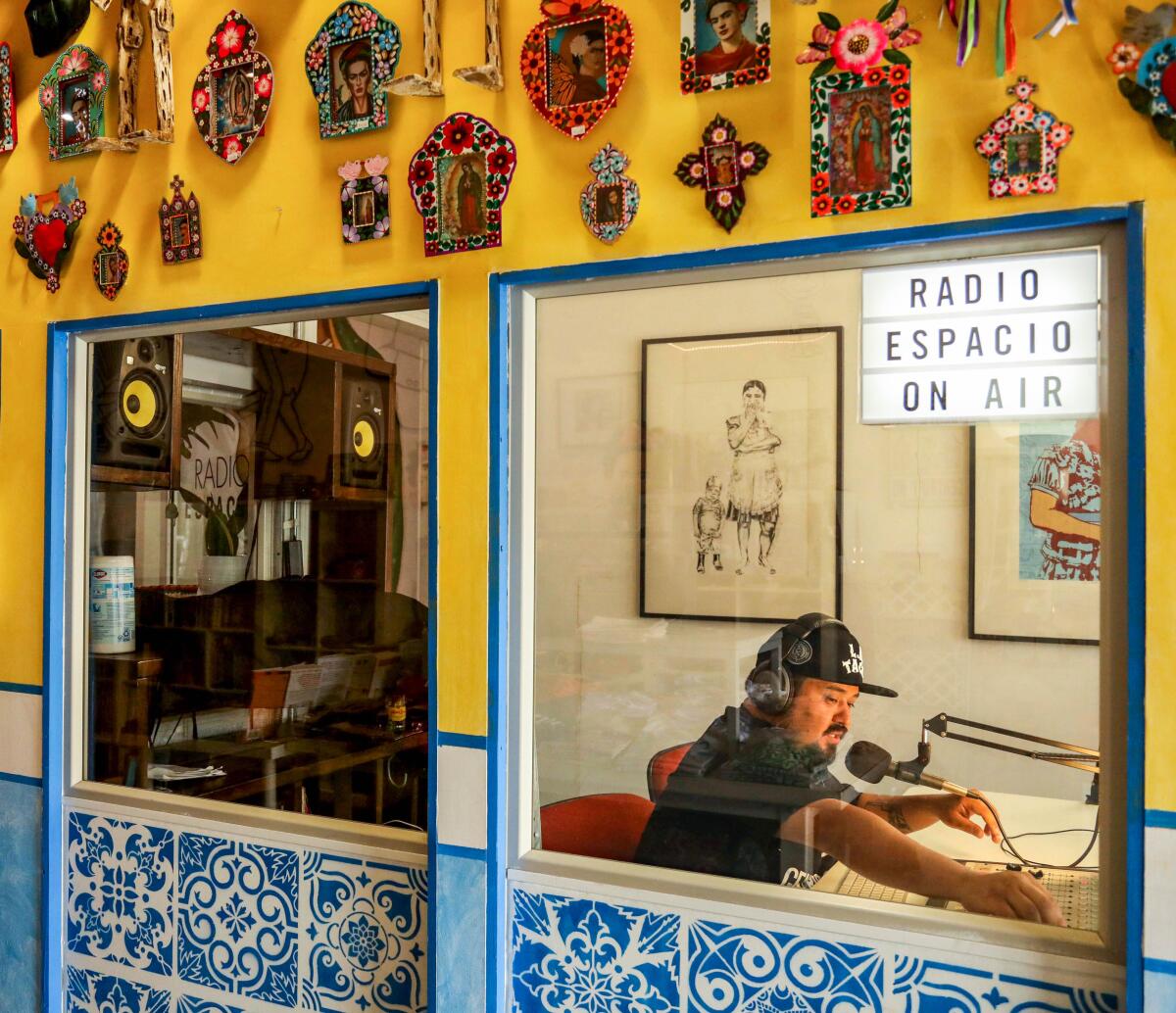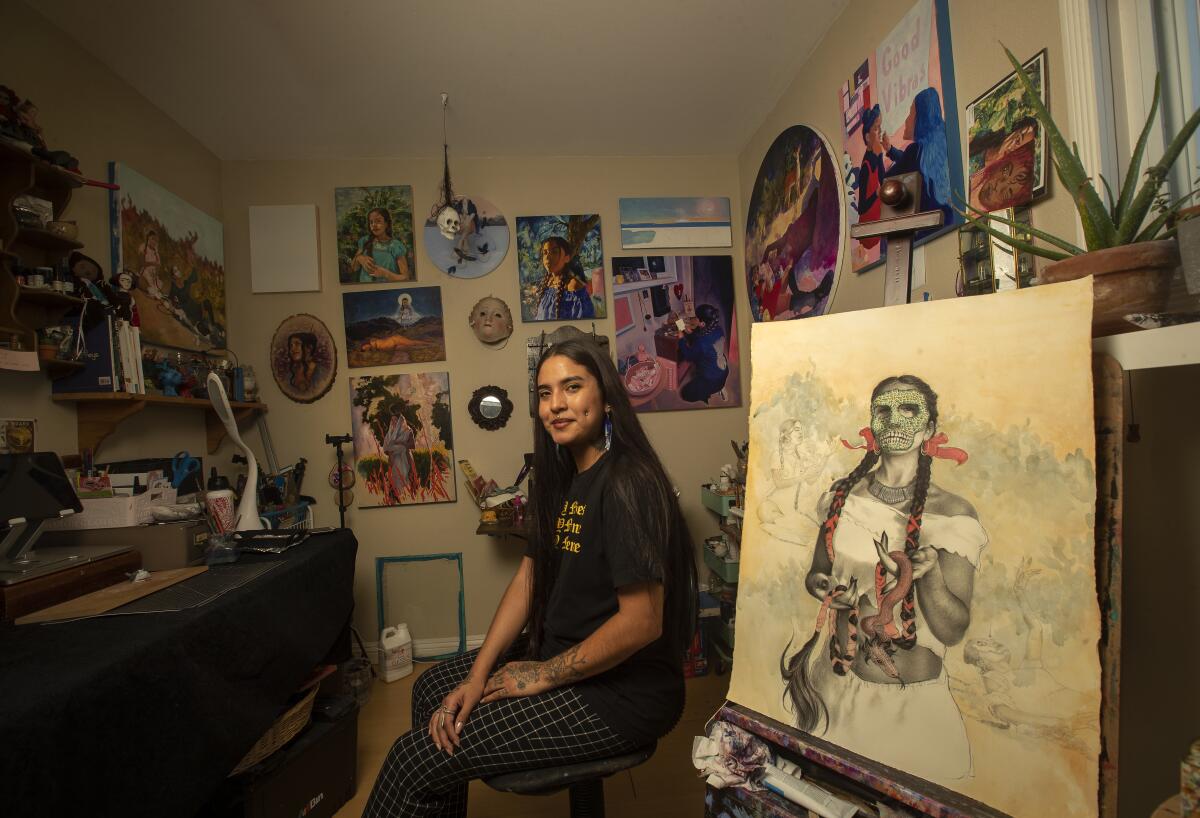The complete guide to home viewing
Get Screen Gab for everything about the TV shows and streaming movies everyone’s talking about.
You may occasionally receive promotional content from the Los Angeles Times.


SPECIAL REPORT
Hollywood's Latino Culture Gap
Times journalists examine the complicated history of Latinos in Hollywood and the actions being taken to increase their representation, which remains stubbornly low. FULL COVERAGE
As Erick Huerta made his way to Street Tacos and Grill in Boyle Heights last October, he came across a familiar sight: a production crew flanked by security and, at a short distance, onlookers pausing to take a peek.
They gathered around the cordoned-off area, poised to record with their phones: Latin trap and reggaeton star Bad Bunny was across the street, shooting a commercial for Cheetos.
“It’s hard to find parking on a regular day, so you can just imagine,” said Huerta, who founded the podcast “Órale Boyle Heights” and has lived in the neighborhood for close to two decades.
It’s a disruption, and at times frustration, that’s become hard to avoid: In film, TV series, commercials — even an Elton John music video — Boyle Heights and East L.A. are often the locus of Latinos onscreen.

Ask Southern Californians about the first time they saw a Latino on TV or in theaters, and they’ll often point to Chicano classics set here, like “Zoot Suit,” “American Me,” “Stand and Deliver,” “My Family,” “The Wonderful Ice Cream Suit” — you know, all the movies featuring Edward James Olmos.
Some remember that “Boulevard Nights” (1979) paved the way for subsequent films about gang life in East L.A. like “Blood In, Blood Out” (1993). Others bring up “Born in East L.A.” (1987) and conclude that the plot — in which immigration officials deport a U.S. citizen — isn’t that far-fetched. Indie film fans mention “Real Women Have Curves” (2002), the tale of a bright girl on the Eastside (America Ferrera) who defies her mother’s pressure to lose weight and get married to chart her own life.
“Let’s not forget ‘From Prada to Nada,’” Huerta told The Times, chuckling. In it, East L.A. also serves as a backdrop, the site where the main characters are relegated after their father’s sudden death leaves them penniless. “That one is so bad it’s good,” he said.
Part of a growing cadre of Latino writers speaking out, staffers say the project came with a low budget, poor pay and a brutal schedule.
That pop culture often situates Latino life on the Eastside — a trend picked up by TV series such as Hulu’s East Los High,” which premiered in 2013 — reflects the neighborhood’s history, itself part of Los Angeles’ legacy of housing segregation. As USC historian George J. Sánchez writes in his book “Boyle Heights: How a Los Angeles Neighborhood Became the Future of American Democracy,” government officials and private industry worked hard in the city’s early years to keep nonwhites away from the coast. The Eastside has also been a hub for migrants with experience in organized resistance, fostering a culture of activism that includes the high school walkouts of the ‘60s and the Chicano Moratorium in the ‘70s.
More recently, stagnating incomes and rising rents have brought gentrification to the neighborhood and sparked local efforts to resist displacement, a conflict that — coupled with Boyle Heights’ and East L.A.’s picturesque murals — seems tailor-made for the Hollywood treatment.
This overwhelming focus on just two neighborhoods comes at a cost, though: Latinos make up nearly 50% of L.A. County, and if you looked solely to film and TV, you might think most of them lived in East L.A. and Boyle Heights.
“Vida,” which premiered on Starz in 2018, made Boyle Heights’ gentrification woes central to its storyline: Two sisters (“In the Heights’” Melissa Barrera and “Riverdale’s” Mishel Prada) return to the neighborhood to deal with the aftermath of their mother’s death, including a debt-ridden bar she co-owned that’s in the sights of an unscrupulous real estate developer.
Despite having grown up in the area and being of Mexican heritage, the sisters butt heads with locals, including an antigentrification group based on actual activists. In one scene, a member of the group spray paints “F— White Art” near Nicodim, a real-life art gallery, since relocated, that was a target of antidisplacement efforts.
Then “Vida” itself became engulfed in the conflict. Local protests against filming in the area drove creator Tanya Saracho to shoot parts of the show in Pico-Union, another historically Latino neighborhood.
After seeing all that unfold, why did “Gentefied” co-creators Marvin Lemus and Linda Yvette Chávez think it would be a good idea to film another show in Boyle Heights?
They’re in love with the place.
Lemus, the son of Guatemalan and Mexican immigrants, spent the bulk of his youth in Bakersfield — a place, he told The Times, he’s only recently grown to love.
It was different with Boyle Heights.
Netflix’s “Gentefied,” executive produced by America Ferrera, confronts gentrification in Boyle Heights. Can it avoid contributing to the problem?
His fiancée introduced him to the neighborhood, taking him to places like Casa 0101, a performing arts center founded by “Real Women Have Curves” playwright and co-screenwriter Josefina López, and Espacio 1839, the curio shop and bookstore that’s home to the community radio station that hosts “Órale Boyle Heights.” She also took Lemus to Eastside Luv, a wine bar whose owner was born in the area and proudly refers to himself as a pocho, a typically pejorative term employed by Mexicans to describe members of the Mexican diaspora in the U.S.
“I’d never felt more at home or complete,” said Lemus, recalling his first visit. Then he learned that some locals thought Eastside Luv was “part of the problem,” one of the businesses catering to interlopers.
“To be honest, I was initially taken aback by that,” said Lemus. “I thought: ‘If you can’t open a business in your own neighborhood, where the f— do we belong?’”
But the nuance of the conflict appealed to him, and he thought it was worth digging into onscreen. He soon tapped Chávez to join him because he wanted a Chicana screenwriter, he said, “who was from L.A. and understood the community.”
Chávez grew up in Norwalk, a suburb in southeast L.A. County. For her, Boyle Heights and East L.A., where her parents first arrived when they migrated from Mexico, are “like Ellis Island,” the place “where we all arrive, where we all go out from.”
Her extended family now covers large swaths of Southern California: “They’re all spreading farther and farther out,” said Chávez — mostly in search of affordable housing. “But, if you meet them, because of the way they act and the way they speak, you’d be, like: ‘You grew up in East L.A.’”
Though heavily rooted in Boyle Heights, “Gentefied” hints at the Latino world beyond. For instance, when Ana and Erik are scrambling for money to bail their grandfather from jail, someone out in Fontana steps up to help.
“We made a lot of references to those places because we wanted to honor the fact que estamos en todos lados, that we’re everywhere,” said Lemus.
Even so, the show’s efforts to cement itself as an authentic representation of Boyle Heights are painstaking, with scenes shot in front of Benjamin Franklin Branch Library, White Memorial hospital and the kiosk and Metro stop at Mariachi Plaza. Characters don shirts advertising Libros Schmibros, the bilingual library and hang-out spot that celebrates its 10-year anniversary in July. They also name-drop local artists like Ernesto Yerena, who crafted the poster used by the Los Angeles teachers’ union during its 2019 strike.
The neighborhood’s activism is what most appeals to Chávez. The “Gentefied” creators even had Boyle Heights’ mariachis play at the premiere of the digital predecessor to their Netflix series, as a nod to the musicians’ 2017 protest against rent hikes at Crescent Canyon Management company’s “Mariachi Crossing” building.
“They came on stage and said: ‘Just so you know, we’re from the community, and we’re being booted out of our homes,’” said Chávez.
“On My Block,” another Netflix series set in the Los Angeles area, takes a different approach.
The show is set in the fictional city of Freeridge, based on co-creator Eddie González’s upbringing in Lynwood, some 15 minutes south of downtown Los Angeles. The community, like his growing up, is composed of hard-working Black and Latino families, and the protagonists’ chief concern is navigating gang-related violence.
Creating Freeridge, González told The Times, gave his team “the freedom to expand the mythology of the story.” In the series, the city is under siege due to a decades-long gang rivalry. González knew that Lynwood residents would demand accuracy about its history, which he respects.
The show, however, does include real places, like Brentwood, an upscale neighborhood on Los Angeles’ Westside.
This too was deliberate, said González, a way to speak to the socioeconomic chasm between the show’s main characters, who come from working-class homes, and one of the characters’ parents, who abandons her.
This divide appears throughout the L.A. Latino film canon, from the bridge that the father in “My Family” crosses to do landscaping for homes in “el pinchi Westside” to the nightlife in “Vida”: In one scene, a drunk young man vomits on the pool deck during a party in the Hollywood Hills, which someone yells out to the Latina maid to clean up. And in “Gentefied,” one character struggles to make a living as an artist without contributing to the displacement of longtime residents, including her own family. This as her patron works to draw artists from West Hollywood and Santa Monica to Boyle Heights.
Despite their differences in setting, both “Gentefied” and “On My Block” feature gang-affiliated characters — a common Latino stereotype in film and TV for which the series’ creators make no apologies.
In “On My Block,” two central characters are part of the Santos gang, including “Spooky,” who, at the start of the show, is newly released from prison, with a teardrop tattoo under his eye.
“I know there are people who criticize putting gang members in shows,” said González. “I can tell you this: I don’t plan on taking them out anytime soon.”
As a filmmaker, he believes “it’s important to humanize them for other people to see that sometimes you don’t pick a life.”
In “On My Block,” viewers slowly learn that Spooky singlehandedly raised his younger brother, putting aside his ambitions to provide for him.
“To me, one of the coolest things would be to have someone who grew up completely removed from this world — in Greenwich, Connecticut, or something — tell me that the character they most relate to is Spooky,” said González.
Imagine if “Sixteen Candles” got a modern-day ’hood makeover.
Chávez shares this perspective.
“When I write about certain characters ... I’m thinking about my brother, my cousin, my ex — about a lot of men in our community who are misunderstood and who I’ve experienced to be brilliant, compassionate and very loving,” she said.
“The push to make shows about Latinos without maids and gardeners and cholos is damaging to working-class communities,” Chávez added. “For me, it’s not about erasing them from the narrative to make ourselves look good. It’s about telling their stories in a way that is three-dimensional.”
Three-dimensionality also means portraying diversity among Latinos. In “Gentefied,” Venezuelan comedian Francisco Ramos plays an employee at a fancy restaurant in the Arts District, a character intended to signal that not all Latinos in Los Angeles are of Mexican descent.
“We also try our best to incorporate as many body types and skin tones and genders as we can,” Lemus said. “One show can’t do everything, but we definitely try.”
Creating opportunities for others also matters to the shows’ creators. From casting to crew members to craft services, said Chávez, “representation is top of mind in everything that we do.”
“Marvin and I know that there are very few people like us in positions of power” she added. “So who else is going to open those doors?”

One of the creatives who got a break through “Gentefied” was Emilia Cruz, an artist based in Simi Valley who was commissioned to paint several pieces for the series, including one featuring two luchadores (wrestlers) kissing.
The exposure led to an influx of Instagram followers and commissions, but it also gave Cruz something more: an exhibition of her work at Plaza de La Raza, an arts center in Lincoln Heights where Cruz teaches, for a scene in the Season 1 finale.
“I’d never seen all of my pieces together in that way,” she said. “It definitely inspired me to get to that point.”
Shortly before Cruz’s work was featured in “Gentefied,” it graced the cover of Dryland, a literary journal born in South-Central. Viva Padilla founded the project in 2015 with the intention of providing a space for voices that typically go unheard.
As someone who recently moved to Boyle Heights, she understands the pull of the neighborhood. Still, she hopes the film industry will open its eyes to the vast array of Latinos who call Southern California home.
“It’s really in their best interest,” said Padilla. “They’re missing out on so many great stories.”
The complete guide to home viewing
Get Screen Gab for everything about the TV shows and streaming movies everyone’s talking about.
You may occasionally receive promotional content from the Los Angeles Times.